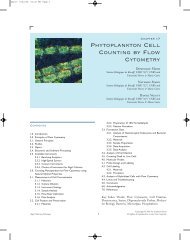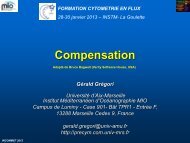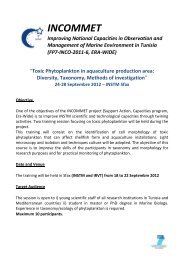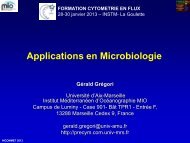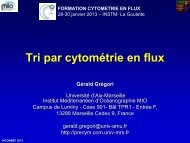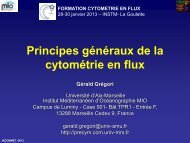Eukaryotic Picoplankton in Surface Oceans - incommet
Eukaryotic Picoplankton in Surface Oceans - incommet
Eukaryotic Picoplankton in Surface Oceans - incommet
You also want an ePaper? Increase the reach of your titles
YUMPU automatically turns print PDFs into web optimized ePapers that Google loves.
Annu. Rev. Microbiol. 2011.65:91-110. Downloaded from www.annualreviews.org<br />
by CSIC - Consejo Superior de Investigaciones Cientificas on 09/27/11. For personal use only.<br />
6% of sequences (Figure 4), a value that <strong>in</strong>creases<br />
to 15% <strong>in</strong> studies that deal only with<br />
picoeukaryotes (Figure 4c). The picoplankters<br />
Micromonas, Ostreococcus,andBathycoccus are the<br />
best represented <strong>in</strong> cultures and clone libraries<br />
albeit other clades, <strong>in</strong>clud<strong>in</strong>g new ones, are also<br />
seen <strong>in</strong> the sea (76). Micromonas pusilla is easily<br />
culturable and expla<strong>in</strong>s a large fraction of PPE<br />
cells <strong>in</strong> coastal sites (60, 80, 88). Ostreococcus are<br />
widely distributed and seem more abundant at<br />
the deep chlorophyll maximum (16). Stra<strong>in</strong>s of<br />
Micromonas and Ostreococcus with little but measurable<br />
genetic difference appear better adapted<br />
to a given condition such as light or temperature<br />
and are regarded as ecotypes of the same species<br />
(51, 68). Pigment, plastid 16S rDNA, and FISH<br />
analyses confirm the relevance of pras<strong>in</strong>ophytes<br />
<strong>in</strong> coastal sites and their lower contribution<br />
offshore (88).<br />
Picopras<strong>in</strong>ophytes provide a unique opportunity<br />
for genome projects of ecologically<br />
relevant picoeukaryotes. The genomes of two<br />
Ostreococcus and two Micromonas stra<strong>in</strong>s have<br />
been sequenced and compared (86) and more<br />
are <strong>in</strong> the pipel<strong>in</strong>e. Ostreococcus, the smallest<br />
eukaryote known (0.8 μm diameter), has a<br />
small genome with 13 Mb and 8,000 genes.<br />
This m<strong>in</strong>iaturized cell ma<strong>in</strong>ta<strong>in</strong>s the complete<br />
genetic set for resource acquisition and photosynthesis<br />
and exhibits a high gene density<br />
due to low gene copy numbers and <strong>in</strong>tergenic<br />
reductions. Micromonas stra<strong>in</strong>s have a larger<br />
genome (20 Mb and 10,000 genes), which<br />
provides a higher ecological flexibility with<br />
more genes for nutrient transport or chemical<br />
protection. Comparative genomics reveals a<br />
core genome shared among related species and<br />
an accessory genome unique to a given stra<strong>in</strong>.<br />
Unique genes seem to provide new metabolic<br />
capabilities and are often related to distant<br />
evolutionary l<strong>in</strong>eages, suggest<strong>in</strong>g horizontal<br />
gene transfer <strong>in</strong> eukaryotic evolution (63).<br />
CCTH: Haptophytes, Cryptophytes,<br />
and Picobiliphytes<br />
This newly described supergroup (9), perhaps<br />
<strong>in</strong>clud<strong>in</strong>g picobiliphytes as well, expla<strong>in</strong>s 6%<br />
of sequences <strong>in</strong> our dataset (Figure 4). Haptophytes<br />
dom<strong>in</strong>ate the PPE component <strong>in</strong> offshore<br />
systems as seen by HPLC pigments<br />
(42, 60), plastid rDNA (45), psbA transcripts<br />
(53), and FISH counts (32% of eukaryotes;<br />
36). Their low clonal share (2%) could be expla<strong>in</strong>ed<br />
by suboptimal PCR amplification due<br />
to high G+C content (49). Picohaptophytes belong<br />
to several novel taxa distant from coccolithophores,<br />
a group well known by its calcium<br />
carbonate plates. Their contribution to chlorophyll<br />
a stock is ∼25%–50% globally, among the<br />
largest for a s<strong>in</strong>gle algal group (18, 49). A key<br />
factor for the ecological success of these t<strong>in</strong>y<br />
algae could be their phagotrophic capacity. A<br />
metagenomic survey based on flow cytometric<br />
sorted populations provides <strong>in</strong>itial data about<br />
their gene content, genome structure, and ecological<br />
adaptations (18).<br />
Cryptophytes are mar<strong>in</strong>e algae easily identifiable<br />
by epifluorescence microscopy by their<br />
chloroplasts with phycobil<strong>in</strong>s. They are relatively<br />
abundant <strong>in</strong> coastal systems and less so<br />
offshore (45, 60). Picobiliphytes represent one<br />
of the deepest evolutionary branches without<br />
a cultured member (61). They were <strong>in</strong>itially<br />
described as phycobil<strong>in</strong>-conta<strong>in</strong><strong>in</strong>g algae, but<br />
could also be heterotrophs (33). Microscopic<br />
observations of cryptophytes and picobiliphytes<br />
<strong>in</strong>dicate that they are slightly larger than 3 μm<br />
(17), so the signal detected is probably due<br />
to small nanoplankters squeez<strong>in</strong>g through the<br />
filters.<br />
Excavates, Opisthokonts,<br />
and Amoebozoans<br />
These supergroups of generally heterotrophic<br />
eukaryotes are poorly represented <strong>in</strong> mar<strong>in</strong>e<br />
surveys (Figure 4). The large excavate radiation<br />
of anaerobic symbionts is not detected.<br />
The second excavate radiation <strong>in</strong>cludes wellknown<br />
heterotrophic flagellates such as k<strong>in</strong>etoplastids<br />
and diplonemids and accounts for 1.4%<br />
of sequences. These could expla<strong>in</strong> a fraction<br />
of HPE cells. Opisthokonta unite metazoans<br />
and fungi with protists such as choanoflagellates.<br />
Choanoflagellates are small (3–10 μm)<br />
www.annualreviews.org • Mar<strong>in</strong>e Picoeukaryotes 101



